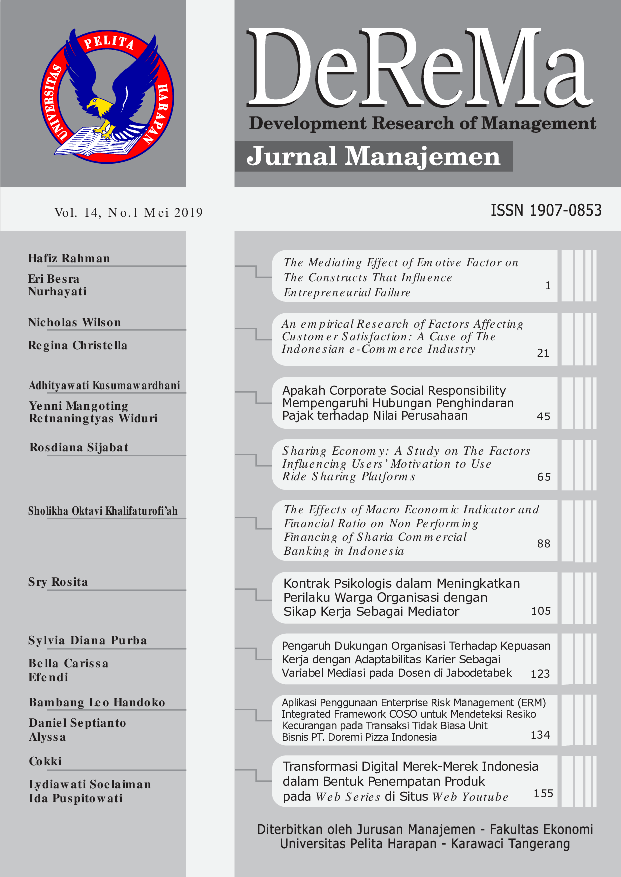The Effects of Macro Economic Indicator and Financial Ratio on Non Performing Financing of Sharia Commercial Banking in Indonesia
DOI:
https://doi.org/10.19166/derema.v14i1.1376Λέξεις-κλειδιά:
non-performing financing, macroeconomic indicators, financial ratio, VARΠερίληψη
This research aims to analyze the relationships and effects of macroeconomic indicator variable and financial ratio on non performing financing (NPF) of sharia commercial banks in Indonesia. Data used in this research is obtained from Bank Indonesia, Central Bureau of Statistics (BPS), and Financial Services Authority (OJK). This research uses time series data from January 2010 to August 2016. This research method uses quantitative method by VAR approach through eviews program. This research showed that there was no long-run equilibrium relationship between variables of NPF, inflation, exchange rate, FDR, CAR and OER. Besides, all independent variables simultaneously affected NPF variable. Based on variable contribution on NPF shock, macroeconomic indicator variables contributed on NPF shock were inflation and exchange rate, meanwhile financial ratio variables contributed on NPF shock were CAR and OER. Seen from NPF response, only CAR variable was responded positively in the early period, meanwhile other variables were responded negative and fluctuatingly. The effects of each variable on NPF were temporary since those effects would vanish after an over-five month period. Based on causality test, there was only a one-way relationship from FDR to OER
Bahasa Indonesia Abstrak: Penelitian ini bertujuan untuk menganalisis hubungan dan pengaruh variabel indikator makroekonomi dan rasio keuangan terhadap non performing financing (NPF) pada bank umum syariah di Indonesia. Data yang digunakan dalam penelitian ini diperoleh dari Bank Indonesia, Badan Pusat Statistik dan Otoritas Jasa Keuangan. Penelitian ini menggunakan data time series dari bulan Januari 2010 sampai dengan Agustus 2016. Metode penelitian ini menggunakan metode kuantitatif dengan pendekatan VAR melalui program eviews. Hasil penelitian menunjukkan bahwa tidak terdapat hubungan keseimbangan jangka panjang di antara variabel NPF, GDP, Inflasi, nilai tukar, FDR, CAR, dan OER. Selain itu, seluruh variabel independen berpengaruh secara simultan terhadap variabel NPF. Berdasarkan kontribusi variabel terhadap shock NPF, variabel indikator makroekonomi yang berkontribusi terhadap shock NPF adalah inflasi dan kurs, sedangkan variabel rasio keuangan yang berkontribusi terhadap shock NPF adalah CAR dan OER. Dilihat dari respon NPF, hanya variabel CAR yang direspon secara positif oleh NPF pada awal periode sedangkan variabel yang lainnya direspon secara negatif dengan fluktuatif. Pengaruh masing-masing variabel terhadap NPF bersifat sementara karena pengaruh tersebut akan hilang setelah periode lima bulan ke atas. Berdasarkan uji kausalitas, hanya terdapat hubungan searah dari FDR ke OER.
Αναφορές
BI. (2012). Annual Economic Report on Indonesia. In BI, Various Issues. Jakarta: BI press.
Dendawijaya, L. (2009). Kredit Bank. Jakarta: PT Mutiara Sumber Widya.
Enders, W. (2004). Applied Econometrics Time series. Canada: John Wiley and Sons Inc.
Firmansyah, I. (2014). Determinant Of Non Performing Loan: The Case Of Islamic Bank In Indonesia. Buletin Ekonomi Moneter dan Perbankan, 17(2), 251-267.
Gujarati. (2004). Basic Econometrics (4th ed.). New York: Mc Graw Hill.
Havidz, S. A., & Setiawan, C. (2015). Bank Efficiency and Non Performing Financing (NPF) in the Indonesian Islamic Banks. Asian Journal of Economic Modelling, 3(3), 61-79. https://doi.org/10.18488%2Fjournal.8%2F2015.3.3%2F8.3.61.79
Iriani, L. D., & Yuliadi, I. (2015). The Effect of Macroeconomic Variables On Non Performance Financing of Islamic Banks In Indonesia. Economic Journal of Emerging Markets, 7(2), 120-134. https://doi.org/10.20885%2Fejem.vol7.iss2.art5
Khalifaturofi'ah, S. O., & Nasution, Z. (2016). Analisis Faktor-Faktor Yang Mempengaruhi Kinerja Keuangan Bank Umum Konvensional Dan Syariah Di Indonesia. Jurnal Perbankan Syariah, 42-64.
Lin, H.-Y., Farhani, N. H., & Koo, M. (2016). The Impact of Macroeconomic Factors On Credit Risk In Conventional Banks and Islamic Banks:Evidence from Indonesia. International Journal of Financial Research, 7(4), 105-116. https://doi.org/10.5430%2Fijfr.v7n4p105
Messai, A. S., & Jouini, F. (2013). Micro and Macro Determinants of Non Performing Loans. International Journal of Economics and Financial Issues, 3(4), 852-860.
Mutamimah, & Chasanah, S. N. (2012). Analisis Eksternal dan Internal dalam Menentukan Non Performing Financing Bank Umum Syariah di Indonesia. Jurnal Bisnis dan Ekonomi, 19(1), 49-64.
Nursechafia, & Abduh, M. (2014). The Susceptability of Islamic Bank's Credit Risk Towards Macroeconomic Variables. Journal of Islamic Finance, 3(1), 23-37. https://doi.org/10.12816/0031476
OJK. (2015). Memacu Pertumbuhan Ekonomi Melalui Sektor Jasa Keuangan yang Kontributif, Stabil, dan Inklusif. Jakarta: OJK.
Poetry, Z. D., & Sanrego, Y. D. (2011). Pengaruh Variabel Makro dan Mikro terhadap NPL Perbankan Konvensional dan NPF Perbankan Syariah. Islamic Finance and Business Review, 79-104.
Setiawan, C., & Bagaskara, B. (2016). Non Performing Financing (NPF) and Cost Efficiency of Islamic Banks In Indonesia Period 2012Q1 to 2015Q2. Sixth Asia-Pacific Conference on Global Business, Economics, Finance and Social Sciences (pp. 1-13). Bangkok, Thailand: www.globalbizresearch.org.
Widarjono, A. (2007). Ekonometrika Teori dan Aplikasi untuk Ekonomi dan Bisnis. Yogyakarta: Ekonisia Fakultas Ekonomi UII.
Λήψεις
Δημοσιευμένα
Τεύχος
Ενότητα
Άδεια
Authors who publish with this journal agree to the following terms:
1) Authors retain copyright and grant the journal right of first publication with the work simultaneously licensed under a Creative Commons Attribution License (CC-BY-SA 4.0) that allows others to share the work with an acknowledgement of the work's authorship and initial publication in this journal.
2) Authors are able to enter into separate, additional contractual arrangements for the non-exclusive distribution of the journal's published version of the work (e.g., post it to an institutional repository or publish it in a book), with an acknowledgement of its initial publication in this journal.
3) Authors are permitted and encouraged to post their work online (e.g., in institutional repositories or on their website). The final published PDF should be used and bibliographic details that credit the publication in this journal should be included.





